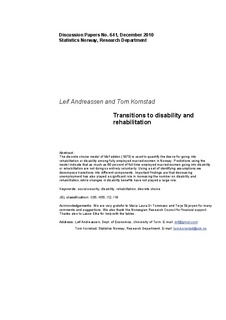| dc.contributor.author | Andreassen, Leif | |
| dc.contributor.author | Kornstad, Tom | |
| dc.date.accessioned | 2011-01-25T12:40:54Z | |
| dc.date.available | 2011-01-25T12:40:54Z | |
| dc.date.issued | 2010 | |
| dc.identifier.issn | 0809-733X | |
| dc.identifier.uri | http://hdl.handle.net/11250/180015 | |
| dc.description.abstract | The discrete choice model of McFadden (1973) is used to quantify the desire for going into rehabilitation or disability among fully employed married women in Norway. Predictions using the model indicate that as much as 60 percent of full-time employed married women going into disability or rehabilitation are not doing so entirely voluntarily. Using a set of identifying assumptions we decompose transitions into different components. Important findings are that decreasing unemployment has also played a significant role in increasing the number on disability and rehabilitation, while changes in disability benefits have not played a large role. | en_US |
| dc.description.sponsorship | Financial support from the Norwegian Research Council. | en_US |
| dc.language.iso | eng | en_US |
| dc.publisher | Statistics Norway, Research Department | en_US |
| dc.relation.ispartofseries | Discussion Papers;641 | |
| dc.subject | Social security | en_US |
| dc.subject | Disability | en_US |
| dc.subject | Rehabilitation | en_US |
| dc.subject | Discrete choice | en_US |
| dc.subject | Quantitative methods | en_US |
| dc.subject | Kvantitative modeller | en_US |
| dc.subject | Trygdemottakere | en_US |
| dc.subject | Kvinner | en_US |
| dc.subject | Rehabilitering | en_US |
| dc.subject | Arbeidstakere | en_US |
| dc.subject | Trygd | en_US |
| dc.subject | JEL classification: C35 | en_US |
| dc.subject | JEL classification: H55 | en_US |
| dc.subject | JEL classification: I12 | en_US |
| dc.subject | JEL classification: I18 | en_US |
| dc.title | Transitions to disability and rehabilitation | en_US |
| dc.type | Working paper | en_US |
| dc.subject.nsi | VDP::Mathematics and natural science: 400::Mathematics: 410 | en_US |
| dc.source.pagenumber | 36 | en_US |
